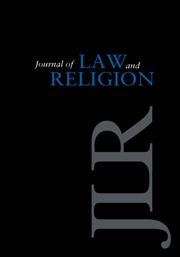No CrossRef data available.
Article contents
Belonging in the Land and the Law: A Reading of Joseph David on Nahmanides’s Territorial Exegesis - Reviewed: Kinship, Law and Politics: An Anatomy of Belonging. By Joseph E. David. Cambridge: Cambridge University Press, 2020. Pp. 156. $110.00 (cloth); $88.00 (digital). ISBN: 9781108499682.
Review products
Published online by Cambridge University Press: 07 June 2022
Abstract
Joseph E. David’s Kinship, Law and Politics: An Anatomy of Belonging provides an erudite demonstration of how an analytical approach that directs attention to negotiations of belonging in exegetical and legal thinking can yield crucial insight into how social boundaries are defined and defended in throughout human history in a broad array of contexts. Among the examples he brings to illustrate premodern efforts to delineate belonging is Nahmanides’s interpretation of territory based commandments. David shows that Nahmanides made the radical claim that the covenant was firmly linked to the land, so that any people inhabiting the land were obliged to follow it, and complete compliance with divine law could be achieved only in the Land of Israel. This essay examines David’s discussion of Nahmanides’s interpretation of law in the Land of Israel and considers the implications of extending an analysis of conceptions of belonging into other corners of Nahmanides’s career as a commentator, community leader, and teacher.
- Type
- Book Review Symposium on Kinship, Law, and Politics
- Information
- Copyright
- © The Author(s), 2022. Published by Cambridge University Press on behalf of the Center for the Study of Law and Religion at Emory University
References
1 Elman, Yaakov, “‘It Was No Empty Thing’: Nahmanides and the Search for Omnisignificance,” Torah U-Madda Journal, no. 4 (1993): 1–83 Google Scholar.
2 Newman, Aryeh, “The Centrality of Eretz Yisrael in Nachmanides,” Tradition: A Journal of Orthodox Jewish Thought 10, no. 1 (1968): 21–30 Google Scholar; Rabinovitch, Nachum L., “Conquest of the Land of Israel According to the Ramban,” in Crossroads: Halacha and the Modern World, ed. Rosenfeld, Ezra, trans. Ezra Bick (Alon Shvut–Gush Etzion: Zomet Institute, 1988), 2:181–97Google Scholar; Yahalom, Shalem, “Historical Background to Nahmanides’ Acre ‘Sermon for Rosh Ha-Shanah’: The Strengthening of the Catalonian Center,” Sefarad 68, no. 2 (2008): 315–42CrossRefGoogle Scholar.
3 Caputo, Nina, “‘In the Beginning’: Typology, History, and the Unfolding Meaning of Creation in Nahmanides’ Exegesis,” Jewish Social Studies 6, no. 1 (1999): 52–82 Google Scholar; Funkenstein, Amos, “Nahmanides’ Typological Reading of History,” Tziyon 45 (1980): 35–49 Google Scholar (in Hebrew); Miriam Sklarz, “Nahmanides’ Typological Interpretation of the Encounter between Abram and Melchizedek (Gen. 14:18-20),” Journal of Jewish Studies 70, no. 1 (2019): 68–82.
4 See Caputo, Nina, Nahmanides in Medieval Catalonia: History, Community, and Messianism (Notre Dame: University of Notre Dame Press, 2007)Google Scholar, especially 19–51, which deals with Nahmanides’s letter to the French rabbis.



